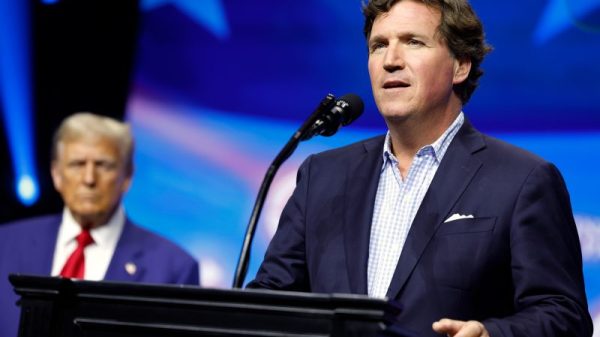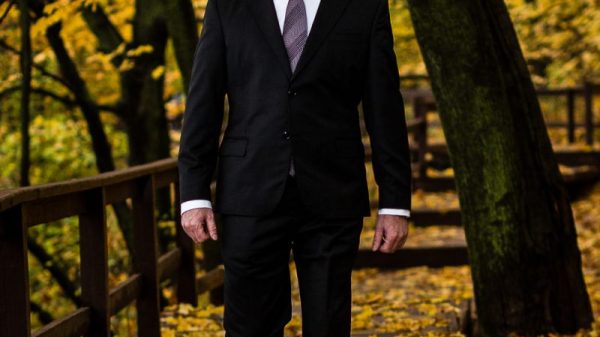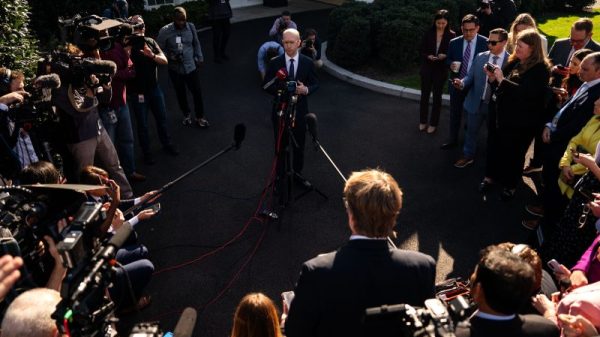The amount of pressure on a football field could make a volcano erupt. Players and coaches are under intense scrutiny, with people eyeing their every move and ready to burst with an emotionally-charged reaction for anything that happens.
The same goes for the officials.
Sports fans have their beloved franchises and their hated rivalries, but there’s one thing even lifelong enemies can seemingly agree on: referees suck.
Whether it’s a missed holding call or an uncertain first down, referees are under constant judgment. For most of the 60 minutes of play, coaches and players will argue their decisions, and fans will hurl endless expletives and threats at the calls they’re certain are wrong.
The life of a referee is not for the faint of heart. Some level above perfection is required to satisfy all parties involved – and it still isn’t enough. And no one knows that more than Dean Blandino, vice president of officiating for the United Football League and Fox Sports rules analyst.
‘What I’ve learned over a long time is it doesn’t matter if you could be really good at what you do, a lot of people are going to think you’re not very good at it, because officiating is just that,’ Blandino told USA TODAY Sports. ‘Half the people are going to be upset about the call, the other half are going to like the call, and then that’s going to switch the next time you make a decision.’
A never-ending list could be made of all the issues people have with officiating, and it would likely take forever to appease the complaints. Even worse, fans really don’t like referees.
But the UFL is trying to bridge the splintered gap between fans and refs. The spring football league has an officiating process you wouldn’t see in the NFL or college football, offering more access and insight into every call made on the field – and possibly pave the way for other leagues.
The UFL invited USA TODAY Sports to Fox Sports’ studio in Los Angeles to get an inside look at how the league’s officiating process works and the big issues in football’s rule enforcement.
How UFL officiating is different than NFL, college football
In the NFL, the head of officiating doesn’t communicate with the on-field officials unless a play is under replay review. It’s mostly the standard in college football as well, as conferences vary in their replay process.
What’s different in the UFL is there’s constant communication between the head official and those on the field. From just before kickoff until the game ends, Blandino is able to speak with the referees on the field.
‘Our goal is not to re-officiate every play from up here,’ he said. ‘We’re not there to check every spot. But if there is something significant, maybe it’s a third-down play going fourth down, or if there’s six or seven yards, something like that, we’ll communicate that.’
It makes for a smooth product. On nearly every play, Blandino can use a multitude of camera angles available at the stadium to ensure whatever call was made on the field is correct – all with an Xbox controller.
The UFL uses the Hawk-Eye cameras, a similar type the NFL will be using for first down measurements during the 2025 season. With the system, Blandino is able to sync several camera angles together to show a certain moment in a play and slow things down. A crew is alongside him to look at all available camera angles, and point him to the right ones that are critical to making the call. He touted the system allows him to ‘start to evaluate (plays) right away’ rather than put everything on hold.
Speed is the name of the game when reviewing. One of the biggest complaints with referees is reviews take too long. Drag it out and people get frustrated with all the time it takes.
Blandino said the speed of replay in the UFL has shortened how long the review process takes. He wants to have a decision made within 60 seconds – unless a commercial break is needed, in which he can take his time. Still, he said the replay center has averaged about 56 seconds per replay stoppage.
‘The goal is always, obviously, we want to be accurate, but we want to be efficient as well,’ he said.
Granted, the UFL is able to do this with a schedule that isn’t as chaotic as the NFL. While the NFL will have several games in the 1 p.m. and 4 p.m. ET Sunday window, the UFL typically has one game at a time, allowing Blandino and head of officiating Mike Pereira to have their undivided attention on one field rather than bouncing around.
What UFL officiating is like
It’s one thing to boast about how effective officiating is in the UFL, but it needs to be seen in action to put it to the test. USA TODAY Sports was in the command center for the final day of the regular season on June 1 for the Arlington Renegades vs. the San Antonio Brahmas and the Birmingham Stallions vs. the Memphis Showboats.
Over the course of the two games, the command center was able to have limited disruptions to the contest. In the first quarter between the Renegades and Brahmas, a play that was initially called a catch on the field was immediately reviewed by Blandino, and he overturned the call. The decision was made quick enough that the ensuing play wasn’t close to being snapped, and by the time he relayed the call to the referees, there wasn’t much time between re-spotting the ball.
“We’re really cognizant of that, and trying to keep those stoppages to a minimum, keep the game flowing,” Blandino said.
In the UFL, there’s super challenges where teams can challenge anything on the field. In the game, one was made by Arlington regarding a potential defensive holding. With the command center crew assisting in finding angles, Blandino was able to rule the challenge was unsuccessful in about 80 seconds.
Another unique aspect about the UFL is the audience can hear what Blandino is looking at, giving viewers a peek into what key components are used to determine a call. He’s able to justify his reviews on-air with the broadcast team, and his deeper explanations to USA TODAY Sports weren’t something you’d get during a game with a replay center.
The pressure on officiating
Even though the day ran smoothly, controversy did arise. In the first quarter of the Birmingham-Memphis contest, the Stallions turned a tip drill into a pick-six, but the Showboats challenged the play for potential hands to the face on quarterback Dresser Winn. While the defender’s hand made contact with Winn’s facemask, Blandino ruled it wasn’t grabbed.
The decision didn’t go well with Memphis, particularly Showboats defensive coordinator Jim Horton, who was visibly frustrated with thecall, pointing to a freeze frame of the play. It was just as tense in the command center as Blandino walked through his decision process, using slow motion replays to make his call. Slow motion and regular speed are the most optimal ways to review a play, as going frame-by-frame doesn’t give concise answers.
‘If I freeze it, I can see the hand here, but what’s happening? How can I tell the force if I freeze it?’ Blandino said. ‘Was it forcible? Was there a grab? The freeze frame does not tell the whole story.’
The call is just one of infinite examples of a decision making people quite upset. It’s pretty much been a thing since sports began, but Blandino believes the intensity of distaste with officials has risen.
He pointed to when he joined the NFL in the mid-1990s. At that time, there was just pressure for officials to make correct calls in real time. Whatever decision was made stood for eternity. Then instant replay was introduced, and it raised the expectation for officials, especially as technology became so advanced to where everything on the field is seen.
‘The technology continues to improve in terms of how we view the game, and I think that raises the expectation on the officials right there. If I can see it, right, why can’t the official see it?’ Blandino said.
Perfection is what everyone on a football field – including referees – strives for, and it doesn’t always happen, leading to concerning situations for officials. The National Association of Sports Officials noted in a 2023 survey more than half of respondents reported instances of not feeling safe as a result of players, coaches or spectators. Blandino added the rise of sports betting has raised tensions further, as one call could decide whether a bettor hits it big or not.
While replay is available at the collegiate and professional level, it’s not in youth leagues and high school. But regardless of level, Blandino wants people to remember plays happen quickly, and on the field referees have to make a quick judgment based on their point of view – not yours.
‘I really feel there’s a disconnect in how we watch the game on television, and how the game is officiated or watched live. Because you see it once at full speed as an official and then you’re evaluated based on seven different angles, slow motion, all these different technological advancements that we have,’ he said. ‘The expectation continues to be perfection, which isn’t possible, right?
‘Coaches make mistakes. Players make mistakes. Officials make mistakes.’
Pushing toward more transparency in officiating
Despite the pressure facing officials, there is a silver lining being produced in the UFL in transparency. The league allows fans to see the process of its officiating, and viewers getting the scoop helps repair the relationship between the two sides.
The access has helped ‘a push for more transparency’ within officiating, Blandino said, and small steps are being made in other leagues, like how the Atlantic Coast Conference has cameras in its command center so viewers can see what’s going on during the broadcast.
It’s not like that at the NFL, and Blandino said he’s not sure it will ever get that much transparency on Sundays. But he noted the league has made strides, such as clueing him in on calls when he serves as a network rules analyst. It’s not everything, but it’s something as the world of officiating evolves.
The UFL has helped football fans get a better understanding of why certain calls are made – but that doesn’t mean they are satisfied with it. Sports will always need a scapegoat. The game is progressing in the right direction, but maybe the relationship between fans and officials is forever meant to be complicated.
‘They still disagree,’ Blandino said of fans. ‘They may think that I need my eyes checked or whatever. But, yeah, they understand the process and they have a better feel for it.’




























